Posted by R. John Howe on 05-19-2005 09:08 AM:
A "Kungrad Kyrgyz" Fragment
Dear folks –
For perhaps the past five years I have been attracted to
and searching for an instance of a particular non-Turkmen Central Asian bag
face. Recently I encountered and bought a fragment of one.
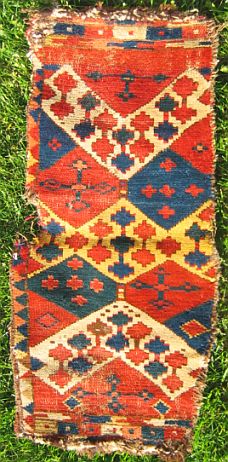
My fragment is 31 inches long
and 15 wide and was likely about two inches wider. This format is variously
described in the literature. It is the face of a bag that had a back and an
opening on one of its narrow sides. It is similar to the Balouch “balisht,” some
versions of the Persian “pushti,” is called a “nampramach” by the Uzbeks, an
“ilgiche” by the Lakai.” The Kyrgyz call it a “chavadan” and it was placed
(often with valuables) at the bottom of the “juk” facing out. (The “juk” was a
place in the tent in which valuable textiles were piled.)
This piece has
for me nice color saturation (some dyes may well be synthetics but I do not find
them distracting)
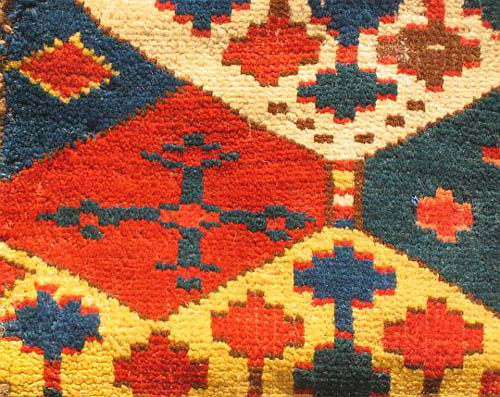
and the ikat-derived graphics have very real
“punch.”
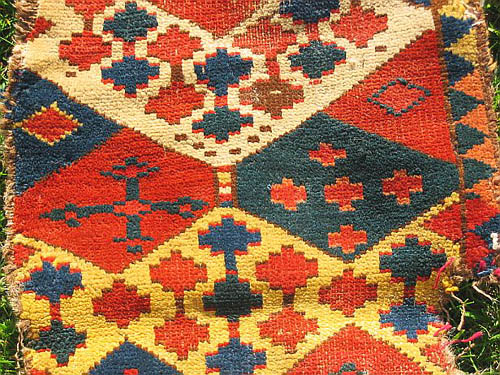
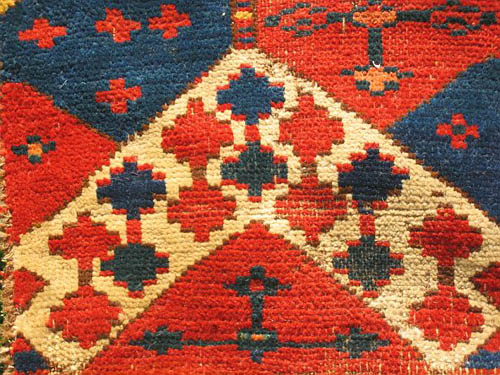
It exhibits a some strong
reds and a very strong yellow and is one of the pieces that I like despite the
latter.
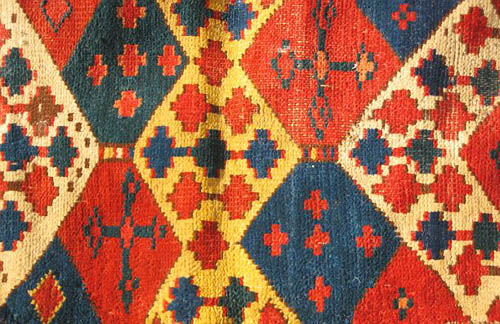
The first
of these I saw had Tajik attributions. The dealer from whom I bought this one
described it as Uzbek. More, the piece is single-wefted, something that used to
tempt us to think Kyrghyz.
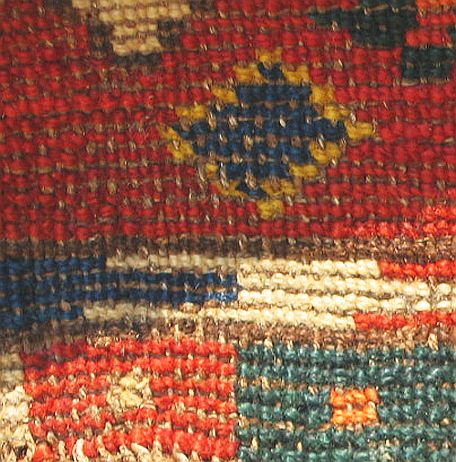
In fact, the only current similar published piece I know of (I
have seen perhaps four or five now “in the wool”) is at the end of George
O’Bannon’s “The Kyrgyz Carpet 1,” 2000, in which George primarily provides
translation of the work of the Russian scholar K. I. Antipina.
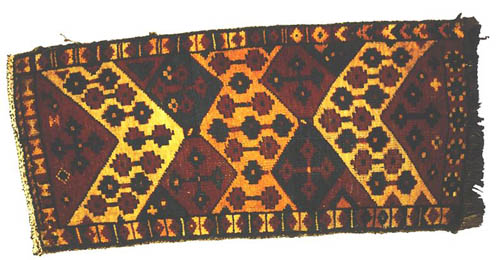
This piece occurs in a
short section that George calls “The Kungrad Kygyz.” in which he draws on the
work of another Russian rug scholar, Karmysheva. Here is what George says at the
beginning of this section:
“…Relying on brief comments in the work of
Karmysheva and some of her unpublished materials, it is possible that another
distinct group of Krygyz weaving may be identified. The are of the Kungrad
Kyrgyz who live in southern Tajikistan…Karmysheva’s notes indicate that this
group of Kungrad Kyrgyz moved into Tajikistan from the Charjou area of
Turkmenistan. This may be a possible explanation for the presence of Turkmen
guls in their pattern repertoire…”
George says that the weavings of the
Kungrad Kyrgyz are distinguished from those of the main Kyrgyz group because
they have asymmetric knots open to the right rather than to the left. He also
says that all of the Kungrad Kyrgyz pile weavings are
single-wefted.
George offers one other chavadan in this short section
that looks like this.
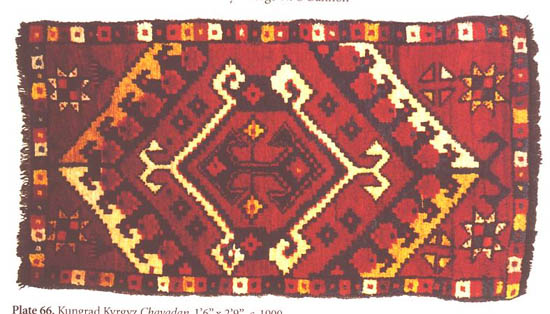
Notice that the borders on this piece are the same as those on
the ends of mine.
So that is what the literature currently says about
what my fragment might be.
It is likely a restoration project. Most of
these pieces are seen to have been made in the early 20th century, so I will not
be moving in on “history” much if I have someone repile in places and put back
the missing border on one side. If I do, I’ll show you the results of that work
some day.
Frank comments are invited.
Regards,
R. John
Howe
Posted by David R.E. Hunt on 05-19-2005 11:08 PM:
Total Recall
Hi John
Interesting find. Shame it's not in better condition, but
still nice. Should I take it that not much study has been undertaken regarding
this particular type of bagface? I remembered one from the Middle Amu
Darya thread, which you can find below

I'll try to remember from
where it's copied 
Would it be better to refrain from the repair expenditure and use the
proceeds to track down a superior example? I think your fragment does a great
job of telling the story in it's present condition. There could be much to
learn, I believe, from the relationships which exist between these Turkmen,
Kirghiz, and Uzbek weavings.
Dave
Posted by R. John Howe on 05-20-2005 06:20 AM:
Hi David -
Thanks for this additional example.
Yes, O'Bannon's
treatment based on this Russian author is the only one I know.
About
finding a better one, I did --- early --- but it was priced at $3,300, and that
discouraged me. A second one I encountered, I think, at Burlingame at an ACOR,
had "off" colors and was a mere $2,200. I've actually looked at this one for
about six months before buying precisely because I was looking for a better one
that I could afford.
One thing that made me buy this fragment is that
some of the pieces in this format and design seem to have a different and darker
palette. I am more attracted to those that have clearer, lighter reds, even if
these are sometimes a bit bright. Both of these other pieces have a darker
palette that attracts me less (although I suspect that the piece in George's
Kyrgyz book likely has better color than the photo of it there
exhibits).
About restoring it: that can, of course, be argued either way.
But as you likely know, the Turkish restorers are doing wonderful things
nowadays at affordable prices, and since this is likely a somewhat younger
piece, I have fewer qualms about tampering with a serious piece of history
should I decide to.
Regards,
R. John Howe
Posted by Igo Licht on 05-20-2005 01:23 PM:
Napramach
John,
Another example of the same type. You probably saw it in TM, I
brought it once or twice for rug appreciation mornings. I am familar with 3-4
more examples, one a very good one with very light blue at Jim Blackmon's
exhibition at SF Acor.
Regards, Igo
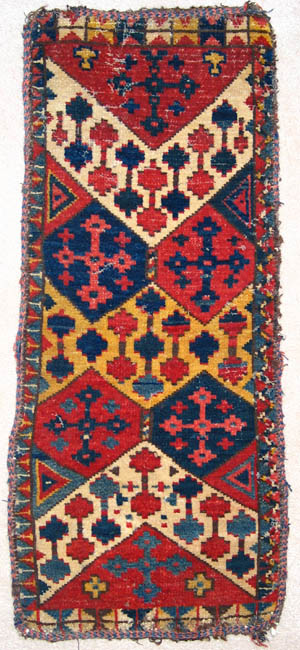
Posted by R. John Howe on 05-20-2005 06:32 PM:
Hi Igo -
Thanks for sharing this image.
I do remember your
piece.
It is one of those with the lighter, clearer reds that I
prefer.
I have not seen the Blackmon piece, but it would likely be a
superior example.
Regards,
R. John Howe
Posted by Filiberto Boncompagni on 05-21-2005 09:03 AM:
Hi John,
I found another one on the web. Different design from yours,
but it’s said to be Uzbek as well.
.jpg)
Regards,
Filiberto
Posted by David R.E. Hunt on 05-21-2005 04:21 PM:
Hi John
I didn't realize that these were either so rare or so
expensive.
I took the liberty of adjusting the colors of my above posted
image, trying to make the details more discenable, and lightening it
considerably in the process.
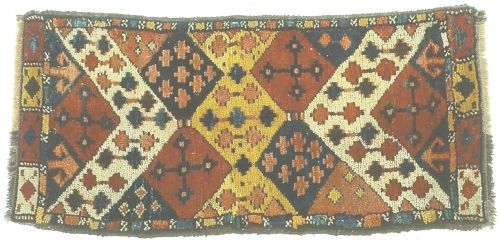
Would you characterize
those pieces which you have seen in the wool as representing or falling into two
distinct classes, representing those of brighter dyes vs those of darker, as
evident in the above photos? Or both published and in the wool
pieces?
Also, what are the structural attribites of your chavadan? We
know that it's single wefted, and I'm assuming, based upon your indications,
that it could be Kungrad Kyrgyz and hence assymetrical open to the right. Is
this correct?
Dave
Posted by R. John Howe on 05-21-2005 05:53 PM:
David -
Yes, David my piece has asymmetric knots open to the right and
is single wefted.
There is, as I said, very little research (at least in
English) on this group.
Yes, O'Bannon in his report on these pieces says
that the ones with the lighter palette and Turkmen devices are conjectured to
have been made by Kungrad Kyrgyz who came from Turkmenistan and so presumably
have been exposed to Turkmen designs and colorations. Apparently the darker
palette is the result of influence by the colors traditionally used by other
Kyrgyz weavers.
But the relationship is not clean with regard to devices.
If you note above the published piece with the same design as mine has the
darker palette. So we have pieces with the ikat based design that have both
color palettes.
The ikat design piece with the darker palette is owned
by Dennis Marquard, the book dealer, and I have been hoping that he might chime
in, since he collects non-Turkmen Central Asian pieces, and likely knows things
in this area.
Regards,
R. John Howe
Posted by David R.E. Hunt on 05-21-2005 11:51 PM:
Off On A Tangent...
Hi John
While we are waiting, let's check out some other examples of
these ikat derived patterns.
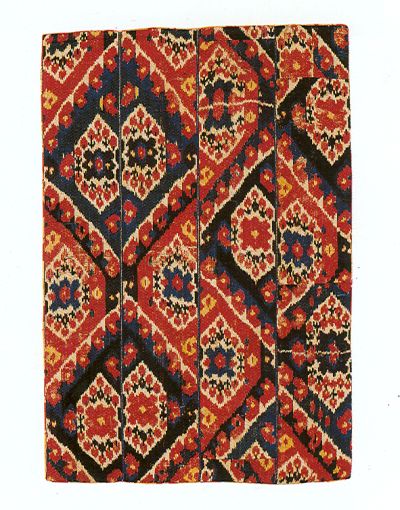
The above ikat sample is from pg.91 of "Between Black Desert
and Red" and accompanied by the following caption, courtesy of Pinner and
Eiland.
"Ikats of this type, probably woven by Uzbeks in urban centers
such ad Bukhara, were the source of similar designs used by the
Ersari."
As such are the following.
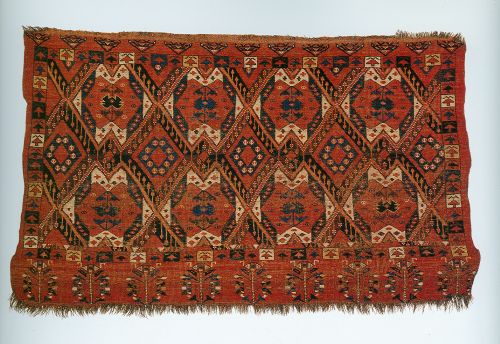
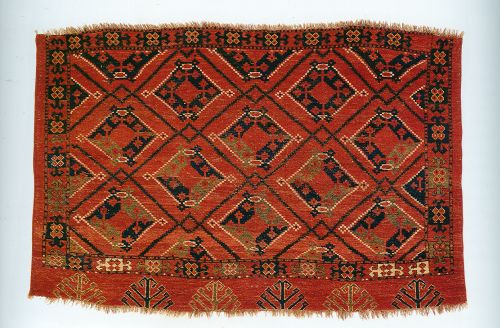
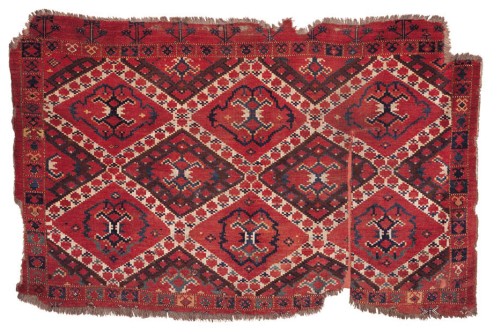
All three of the above are
courtesy of "Between Black Desert and Red".
This silk ikat garment
from an exhibition review by Wendel R. Swan, Ikats :Good As
Goldman
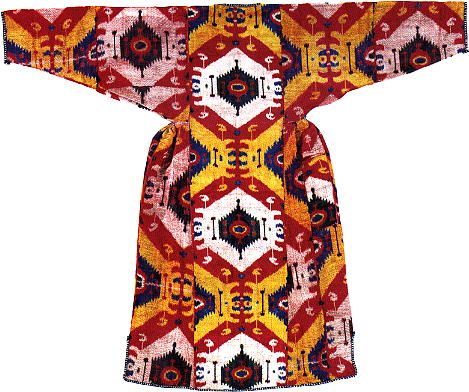
Dave
Posted by R. John Howe on 05-24-2005 01:49 PM:
Maybe "Uzbek" Rather Than "Kungrad Kyghyz"
Dear folks -
Dennis Marquard, who owns the piece I have discussed
above that George O'Bannon published, contacted me off board with some
additional information about both this piece and his own feelings about its
attribution.
Since he is an active rug book dealer, he feels that he
should not post directly here since this might be seen as infringing on the
non-commercial mode we intend and that he respects.
But he is willing to
respond to my query to him about the issues here “around the corner,” so to
speak, via email messages and phone calls with me.
He has given me
permission to post two images he has provided me, to quote what he said to me in
an email and to summarize some additional indications he made to me about all of
this in a phone conversation tonight.
First, Dennis in fact owns two
pieces similar to my fragment.
Here is his own image of the piece that
O'Bannon published as Plate 67 in “Kyrgyz I.”
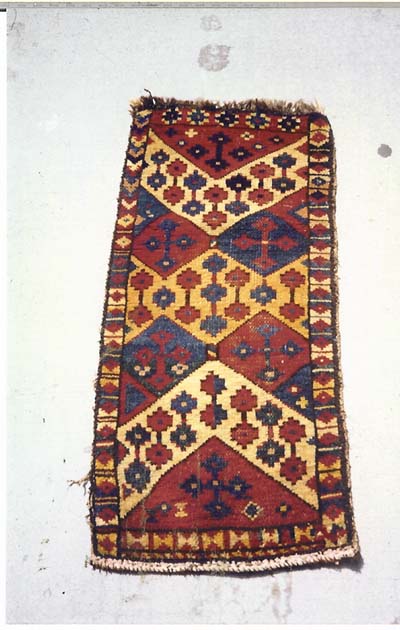
The first thing to note is
how bad the photo is of this piece in “Kyrgyz I”

My indication above that this is
a piece with the darker more typical “Kyrgyz” palette is incorrect. This piece,
too, has the lighter, clear reds that appear on the piece Igo Licht owns, and my
own fragment. This palette is also used on the piece with a different design
that Filiberot put up and may be that used on the one with the ikat-based design
that Dave Hunt posted.
Dennis further indicated that he owns a second
piece with this ikat-derived design that is better.
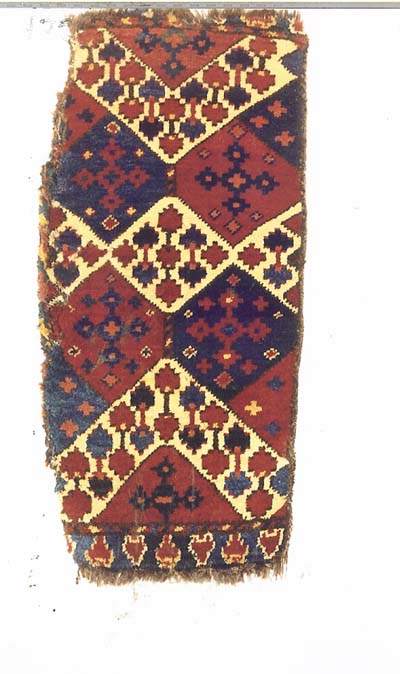
Here it might be best to let him
speak for himself. He has given me permission to quote the following email to me
in which he raises some other issues as
well:
------------------------------------------------------------------------------------
“Hi
John:
“Here are 2 photos of pieces from my collection.
“The one
on the left is shown in O'Bannon's The Kyrgyz Carpet as pl 67, page 107 1'4" x
2' 9". I have attached a better photo.
“The example on the right is slightly
smaller 1' 2" x 2' 5" and is the best I have seen. The pile has highly saturated
colors and is lush and velvety- to -the -touch. One selvedge is intact and
complete. This piece was made without a side border. The pile on the piece to
the right is more coarsely knotted than the published example and I believe it
to be older. In the sunshine, the green colors pop.
“I disagreed with
George about the Kyrgyz attribution of both plates 67 and 30.
Dennis”
------------------------------------------------------------------------------------
There
are several things to note here.
First, Dennis’ second piece, the one he
feels is better was made without side borders.
But more important is his
last sentence (just for those curious Plate 30 in “Kyrgyz I” is of a saddle
cover that Dennis now owns. George gave it a Kyrgyz attribution. Dennis feels
that it was likely woven in East Turkestan) in which Dennis indicates that he
disagreed with O’Bannon about some of his Kyrgyz attributions and particularly
about his placement of Plate 67 in a specialized Kyrgyz category. Dennis, and
apparently some others, feel that Plate 67 (and I think by extension all of the
piece in this thread with this design and coloration) seems more likely to have
been woven by Uzbeks.
(They retain this attribution despite noting that
Plate 67 is single-wefted, something, as I said above, that used to press us
toward Kyrgyz attributions. It does less so nowadays because some single-wefted
pieces have been encountered now that are clearly Uzbek on the basis of other
indicators.)
There is some considerable feeling among some rug scholars
and collectors of non-Turkman Central Asian materials that George O’Bannon was
too accepting of Russian scholarship and that what we need to strive for is the
knowledge that apparently still resides in rug and textile literature written in
the languages that the Uzbeks and Kyrgyz and their fellow non-Turkmen tribal
groups spoke before Russian and the Russian scholars began to dominate this
literature.
Dennis reminded me that there have been some Hali items on
Kyrghyz pile weaving and on O’Bannon’s translations of Antipina and Beresneva in
particular, so this morning I dug them out.
First, there is an article in
Hali, 123, p. 70 by Seyfullah Turkkan, a collector of Kirghiz pile pieces.
Turkkan cites the two O’Bannon Kyrghyz volumes and acknowledges that Antipina
and Beresneva, writing in the Soviet era, considered their work to be a “’Party
Mission’ in which they had to weigh every word carefully in deference to the
Party’s sensitivity to ethnic matter. But he seems to accept O’Bannon’s
attribution of such ikat-based chavadans at “Kungrad Kyrghyz” since he provides
one on page 78 and retains this label. (Turkkan traveled this area and says
interestingly that he has never seen a Kyrghyz rug being carried and offered for
sale by a Kyrghyz person. They are always in his experience carried and offered
by Uzbeks or memobers of some other ethnic group. Odd.)
The second piece
is a longer review of these two O’Bannon translations by Andy Hale. It is in
Hali, 119, beginning on page 63. Hale reads Russian and has traveled in Central
Asian and studied its textiles for years. He and Kate Fitz Gibbon are the
authors of the widely acclaimed book “Ikat” which is to my mind one of the two
best textile books published during the last 15 years, of which I
know.
Hale is very critical of the “colonialist” framework and
interpretations the Soviet scholars apply to their work, but he is also critical
of O’Bannon’s attributions to the “Kungrad Kyrgyz.”
Here is what he says
about the latter:
“…O’Bannon’s third essay is a complete mystery to me.
This is the discussion of a group of bag-faces woven by an ostensible “Kyrghyz
Kungrad” group is said to be based on his discussions with Belkis Karmusheva,
and the attributions supported by her writings. I discussed this group with
Karmusheva myself in 1996 and reviewed the material in her archives. In her
talks with me and in her writings it was very clear that the group under
discussion was Uzbek and not Kirghiz…”
So Hale is among those who think
that O’Bannon was mistaken about his “Kungrad Kungraz” attributions and thinks
these pieces were woven by Uzbeks. Dennis agrees.
As is clear to those
you read what I write, I am a consumer of such research, not a participant in
it, but one thing that make me uneasy about some of the attributions and shifts
in attribution is that not many indicators are offered.
I think folks
like Andy Hale and Dennis who handle lots of non-Turkmen Central Asian rugs and
textiles think that in a number of ways (handle might be important) the pieces
O’Bannon has attributed to the “Kungrad Kyrghyz” seem to them to resemble more
closely what is usually described as “Uzbek.”
My thanks to Dennis
Marquard for his useful indications, contributions and permissions
here.
Regards,
R. John Howe
Posted by Patrick Weiler on 05-25-2005 02:34 AM:
John,
Here are a couple of photos of a napramach that is not single
wefted:
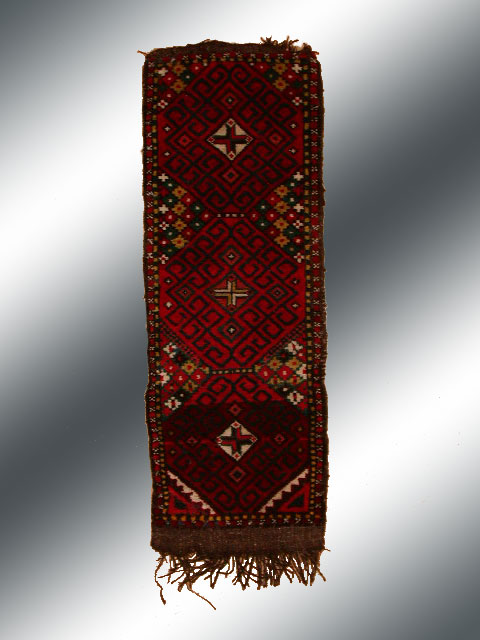
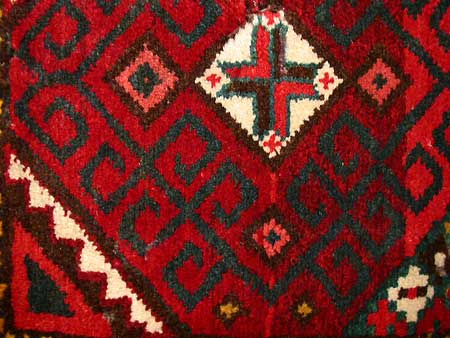
It is obviously younger than your piece, with most likely
chrome dyes. It is 3'4" long and 1'3" wide, with approximately 9x9 asymmetric
knots open left.
It comfortably covers a bench in the entry way. There is
some moth damage here and there.
You can see the several-inch long flatweave
along the bottom, with the ends of the fringe obviously the ends of the original
warps. The top is folded over and sewn down. If this was a bag, the back must
have been separate and sewn onto this piece.
Are any of these known to have
the back extant?
The diamonds which intrude into the field are made of small
stepped diamond motifs which are similar to the barbell-like features in the
white bands of your piece. The step-like design would seem more likely derived
from kilim designs rather than ikat designs. The ikat does not have the type of
vertical design limitation that kilims have.
In fact, most of the designs in
your piece seem more kilim-derived than ikat-derived.
Patrick Weiler
Posted by R. John Howe on 05-25-2005 02:42 PM:
Hi Pat -
I see what you mean but there are also areas with fairly long
vertical color changes of the sorts that kilim weavers would tend to avoid for
fear of weakening the integrity of the fabric.
I was mostly quoting what
the literature tends to say. Turkkan says explicitly in one of his captions that
these are taken from "ikats" O'Bannon is more general indicating that these
designs come from "textiles."
Aside: If you'll remind me of your surface
mail address I'll send you a rug book.
Regards,
R. John Howe
Posted by David R.E. Hunt on 05-26-2005 02:34 AM:
Hi Patrick, John
Find below a photo of a North Afghani flatweave I
own, a product of the Maimani, if memory serves.
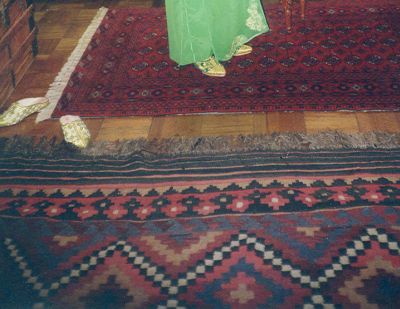
Let's compare this to a
velvet ikat coat from Khalter's "Arts and Crafts of Turkestan", and the design
there of,
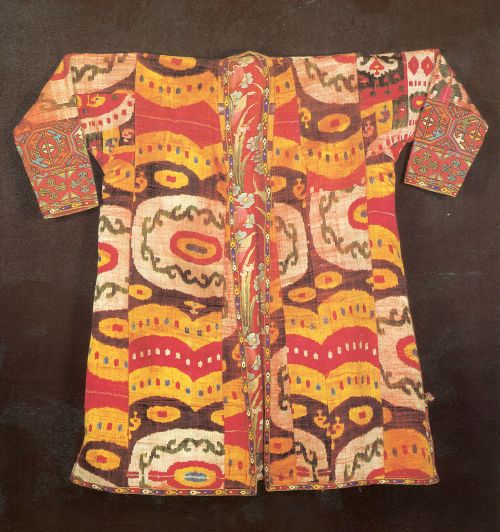
this velvet ikat panel from Hazara Gallery,

and this ikat coat from
Shiv Sikri tribal Arts.

And let's not forget
the weaving that got us here.

As we look over these five fabrics, what strikes first is the
similarities of color. Is this a reflection of the dyes available in this area,
or some form of regional style or preference? Mr Marquard noted above a
particular green, which has drawn my attention at times and which is especially
prominent in the second ikat coat.
Notice that at times the ikat patterns
are blocky and flatweave like, and others fluid. I have a feeling this is more
reflective of the techniques used to plan the design than limitations of the
medium, said limitations being of more practical matters such as intensity of
labor.
I encountered a similar enigma while attempting to devine the
influences upon the Turkmen gul format in my recent salon, and resolved these
inconsistencies by compromise. This Kirgyz bagface design is, I would suggest,
an expression of a regional style which incorporates design influence from both
flatweave and ikat, with ikat design itself being a reflection of flatweave
patterns, and proceeding from both geographic isolation and said isolation of an
extended time frame.
Dave
Posted by Filiberto Boncompagni on 05-26-2005 06:26 AM:
quote:
Since he is an active rug book dealer, he feels that he should not post
directly here since this might be seen as infringing on the non-commercial
mode we intend and that he respects.
While thanking sincerely Mr. Marquand for his sensibility,
I must stress that Turkotek non-commercial policy doesn’t prevent rug dealers
from posting on our boards, as long they do not use them for promoting their
activities.
Mr. Marquand is not even a rug dealer and he is welcomed to
post directly and discuss his pieces - provided they are not for sale, of
course. But this applies to everyone, dealer or not.
Best
regards,
Filiberto
Posted by David R.E. Hunt on 05-26-2005 05:30 PM:
Symmetry
Hi John, Patrick
Find below an ikat panel from The Alberto Levi
Gallery.
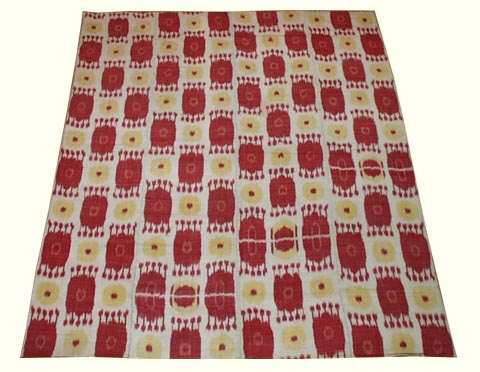
Is
this pattern more a reflection of the techniques used to plan the design than
limitations of the medium?
Dave
Posted by Patrick Weiler on 05-27-2005 01:12 AM:
John,
Thanks to David Hunt and his Maimana kilim, I went exploring my
attic and dungeon for flat weaves with designs akin to those in your pile
weave.
Here is a common Uzbek Tartari bag face I dredged up from the
depths of my collection:
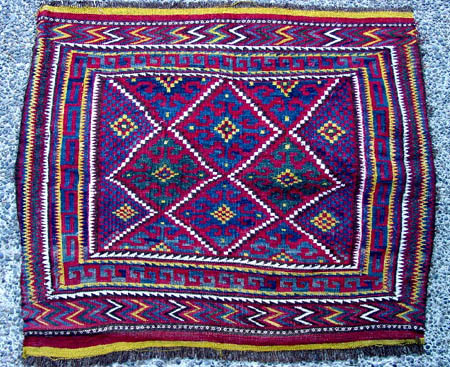
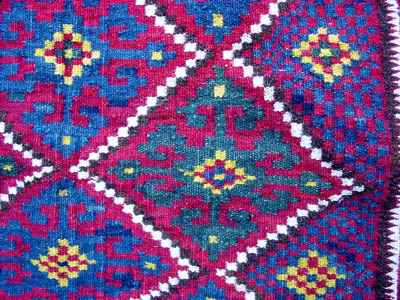
You
may notice that some of the design features are similar to your piece and quite
similar to the Dennis Marquand and Igo Licht pieces.
Perhaps these cruciform
stepped designs were adapted from a flatweave such as this one to become the
more simplified knotted version in your pile piece.
Pat Weiler
Posted by Matthew J. Miller on 05-27-2005 04:51 AM:
ikat
[ Turkkan says explicitly in one of his captions that these are taken from
"ikats" O'Bannon is more general indicating that these designs come from
"textiles."]
Where is the evidence to support this type of definitive
claim? I have personally never read anything that would constitute hard evidence
on the subject, but would love to if someone could point me in the right
direction.
Thanks,
Matthew
Posted by R. John Howe on 05-27-2005 08:32 AM:
Hi Matthew -
I assume the "hard evidence" would be producing an image
of an ikat that had similar design devices in it.
I took a look through
the "Ikat" volume on the Goldman Collection before I put up my initial post and
didn't see anything that seemed particularly close.
I do remember when I
saw the Goldman pieces in exhibition that it seemed to me that only a rather
narrow range of ikat designs had been visibly transferred to pile rugs of which
I knew.
There are a couple of other ikat books (e.g. Vok's) but I don't
have them.
I wouldn't insist on this point, just know that the design on
the fragment I own and those similar to it are frequently described as derived
from ikat designs.
Of course if you've read "Ikat," you've seen that
there was a lot of back and forth design influence. It seems not to have been a
one-way street, as one might expect between modes that are basically not
particularly "restrictive."
Regards,
R. John Howe
Posted by David R.E. Hunt on 05-27-2005 01:54 PM:
Prevailing Fashion
Hi Mat, Pat, and John
The following from Jahannes Kalter's "Arts and
Crafts of Turkestan".
"Better represented in western collections is ikat,
an outstanding product of Turkestan textile handicrafts. This was put to a
variety of uses in Turkestan households as table cloths, niche curtains,
tapestries, bedclothes, covers and cushion covers.
It's exremely varied
patterns range from simple stripes to zigzag patterns through curved lines, to
hooks, "cloudband" and circular ornamentation, classic Islamic motifs such as
combinations of stars and crosses, reminescent of Seljuk tiling, realistic and
abstract human figures and trees of life,"and
"The importance of ikat in
urban culture has been described by D. Dupaigne as follows: Ikat fabrics are
luxuries given as gifts of honour at weddings and other important occasions. The
wealth of a landlord or merchant is indicated by the richness or newness of his
garb. The patterns change anually with the fashion".
While I will be the
first to admit that any of these designs might be the consequence of manifold
borrowings between designs and textiles, it is my understanding that the
representation of ikat patterns in carpets is a given. Granted, the border on
John's piece may be a mimic of this triangle border pattern of the Maimama, but
the yellow "bat wing" device in the center and it's flanking chevrons or "flying
V " seem rather more at ikat than kelim. The existence of such a large, well
defined class of carpets with kindered designs speaks volumes, as does fact that
so many of our rug scholars are compelled to comment on this
subject.
Dave
Posted by Igo Licht on 05-27-2005 04:19 PM:
More examples
I would like to bring two more examples of this class of weavings. The first
one is another Uzbek napramach, very similar to the John's fragment and Dennis'
piece. It appeared on a Web site two years ago. It is interesting how all this
pieces follow the same design structure and colour patterns.
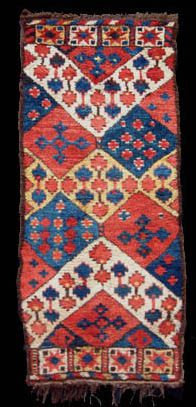
Another example is quite
different, I found it few days ago in NY show. It uses some of the elements
found on the other napramach, but in much less rigorous way, with quite
disorganized lattice and East Turkestan gols. It is also not a single weft
weaving.
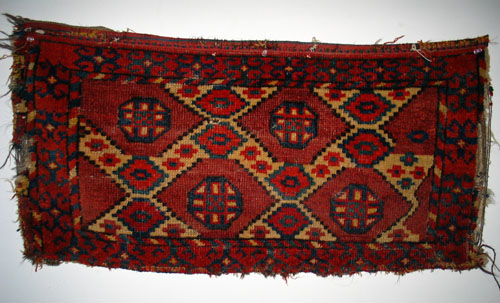
Best Regards,
Igo Licht
Posted by R. John Howe on 05-29-2005 12:38 AM:
Hi Igo -
Thanks for these additional images and comments.
One
small difference I've noted in the design of my piece compared to most of the
others most like it is that the white areas, toward the end on mine, do not move
entirely to the sides but stop a little short.
Here's mine
again.

Here's
yours.

When you showed me the image of this most recent (and
admittedly different) piece last night, I thought initially that the arrangement
of the lattice on it

(despite the fact that it is rotated 90 degrees from that on
mine) might help explain this shortfall in the white areas on
mine.
Looking at it again on my monitor today, I am less
sure.
Still, an interesting and unusual piece.
Looking at a quite
different aspect of it, you mentioned last night that the design seems to
deteriorate or is incompletely rendered in some areas as it approaches the sides
and corners.
This is something we see often in Jaff Kurd bags with
diamond designs. Not sure why this is.
We have conjectured sometimes
with the Jaff Kurds that the use of offset knotting to achieve the sharp angles
of the diamonds may be one source of this tendency, but I don't think we have
established that at all, since there are Jaff Kurd pieces with the diamond
design that are complete to the sides of the field.
Regards,
R.
John Howe
Posted by David R.E. Hunt on 05-29-2005 10:11 PM:
Transference
Hi Igo, John, and All
Find below a scan of a ikat design Ersari Torba
from the Weidersperg collection in "Betweeen Black Desert, Ect.".

Dave
Posted by R. John Howe on 05-30-2005 12:59 AM:
David -
Yes, this last piece lets me see again what I thought I saw in
Igo's second piece, last night.
It seems to me if this design is used so
that the white legs run out, as they do in this Wiedersperg piece that you
present, then we may have an explanation for why sometimes these white ground
areas do not move entirely to the sides.
It seems likely that the weaver
envisioned something like the usage in the Wiedersperg piece in which the white
areas are interrupted by a hexagonal lozenge.
Thanks,
R. John
Howe
Posted by Andy Hale on 06-01-2005 06:11 PM:
Kungrad
My (somewhat random) thoughts on the thread:
In my review of the the
O'Bannon book on the Kirgiz, I point out that the Kungrad are Uzbek. So these
rugs are of the Kungrad tribe of Uzbeks. I have a number of these, collected in
Afghanistan from Kungrad people. I confirmed this viewing pieces in ex Soviet
museums as well as talking with researchers like Karmusheva in Moscow. (By the
way, I speak fair Persian but very little Russian-my wife does the translating
of written material).
Lakai are also Uzbek, of the Kattaghan tribe. Wrote an
article about them (and Kungrad) for Hali some years back. It is also viewable
on the web.
Kungrad seem to like an apricot orange in both embroideries and
weavings.
These are to go on the base of the "chuk". (Chuk is the big pile
of blankets and bedding in the tent-these days in the house, mostly). Only the
front is visible so the backs are usually pretty rough, sometimes out of
recycled materials. Not suprising they get chopped off!
If you look in the
Goldman ikat book, there are two pile pieces of very clear ikat inspired
design-a donkey bag and small carpet. The designs on both are arranged in
misaligned panels, ikat style.
Most Soviet period researchers-especially
Stalin period-are pretty bad. Karmusheva was an exception. She was Tatar-not
Russian and able to speak the local languages. She worked at at very difficult
time but was no commie. On the other hand, she saw herself as an ethnohistorian,
studying textiles was just a means to an end. We will, enshallah, be dealing
with her work in an upcoming book.
I always liked Uzbek rugs, they weren't
popular when I was buying them. Nice to see the interest these days.
Andy
Posted by R._John_Howe on 06-02-2005 12:01 PM:
Designs Sourced in Ikats
Hi Andy –
I don’t think we’ve met (I did meet Kate at a recent TM Rug
Convention at which she spoke), but it’s good to have more knowledgeable people
in our conversations here.
Check your credentials. The word here in DC,
among some who know you, is that you read Russian. 
Here are scans of the two images
in “Ikat” to which you referred.
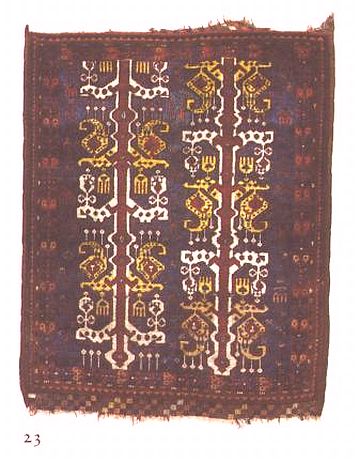
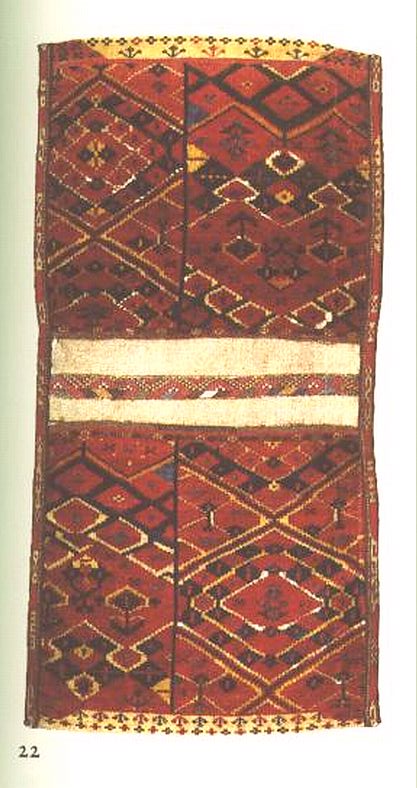
I think your point here
is that these are two pile pieces clearly demonstrating that ikat designs were
sometimes transferred to pile pieces.
One issue being debated here,
though, is whether we can demonstrate that the designs on the piece with which I
began this thread (and on its fellows) likely came from textiles.
Some
think kilim sources are more likely and some are unconvinced that we know at
all. What do you think? How would you describe these designs and
devices?
Thanks,
R. John Howe
Posted by Chuck Wagner on 06-02-2005 01:09 PM:
Hi John,
Here's another example, from Jourdan ( "Turkoman"), showing
an Ersari group pile saddle blanket. He attributes it to the turn of the
century, from the upper reaches of the Amu Darya. It would be tough to argue
that this design isn't derived from ikat patterns; indeed, Jourdan also shows a
velvet ikat coat to make just that point:
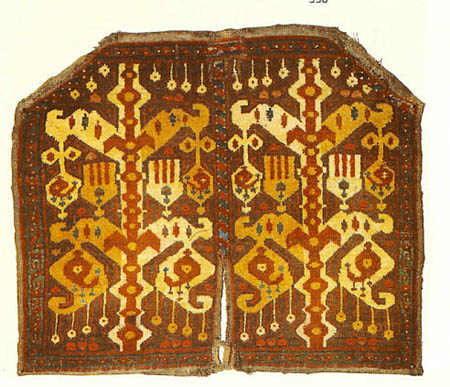
Regards,
Chuck
__________________
Chuck
Wagner
Posted by R._John_Howe on 06-02-2005 10:30 PM:
Hi Chuck -
I have a very similar Beshiri saddle cover to my right on
the wall as I type. Winey red and strong yellow. These same botehs with
appendages (jewelry I've begun to think).
Next to it I have this
piece.
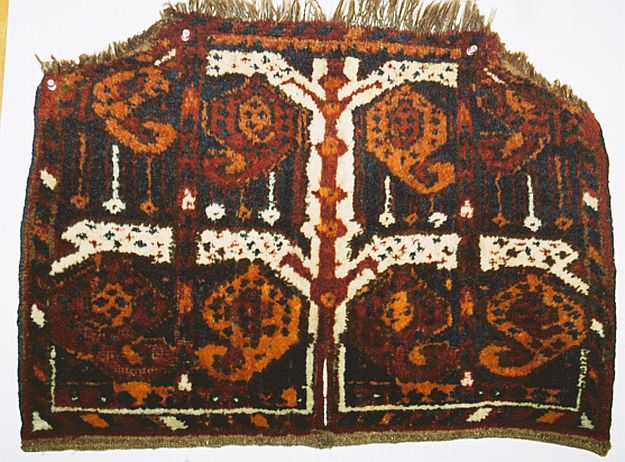
Again most of the same elements but with a ghostly white
central branching spine.
But we're talking now about a more general
question than the one initially posed.
Pat Weiler said that he thought
that the stepped usages in the piece with which I began this thread indicated
that it's devices are sourced in kilims.
I noted that there are some
indications that some see most of the designs in this piece has sourced in
ikats.
Then Matthew Miller questioned in the ikat claims entirely saying
there seemed no evidence offered.
David has put up a variety of ikat
designs and Andy has made a broader reference, as you do, but the specific issue
is still what evidence do we see that the designs in this piece and its
fellows

are
sourced in ikats. For that we seem to have assertions in the literature rather
than specific ikat images containing similar design
features.
Regards,
R. John Howe
Posted by Chuck Wagner on 06-03-2005 12:39 AM:
Hi John,
Well, we might as well toss in the strongly Turkic zili
brocade as another possible element of the overall equation we are discussing.
Not evidence, but intriguing..
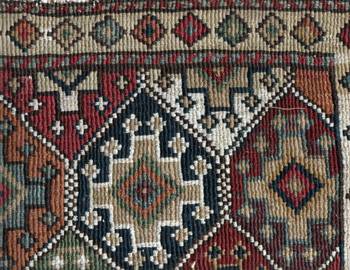
Regards,
Chuck
__________________
Chuck
Wagner
Posted by David R.E. Hunt on 06-03-2005 01:05 AM:
Colors
Hi John
For me it is a combination of factors, and most specially the
colors, which bear most resemblance to the ikat and hence convince me of the
origin of this deign.
Granted there are similarities to the kelim
designs, but it seems that this resemblance is more at kelims in general as
opposed to the kelims indigenous to this region of the world. Neither the
drawing or the colors of the kelims depicted are a really close match to our
Kungrad piece, and while I personally feel that the designs are probably of a
diverse, confabulatory origin, the pallette of these weavings says to me ikat.
Remembering Kalter's assertion that
"The importance of ikat in urban
culture has been described by D. Dupaigne as follows: Ikat fabrics are luxuries
given as gifts of honour at weddings and other important occasions. The wealth
of a landlord or merchant is indicated by the richness or newness of his garb.
The patterns change anually with the fashion ",
we might have to
search for some time to find the precise ikat analog for this Kungrad bag face
design.
Besides, it's not uncommon to see just a small portion of a
design enlarged in scale and utilized as a new carpet pattern, and altered
somewhat during the course of this retrofitting.
All this said, watch
someone come up with a perfect match to this pattern in a kelim 
Dave
Posted by R. John Howe on 06-03-2005 09:07 AM:
Dave -
You said in part: "...watch someone come up with a perfect
match to this pattern in a kelim"
Me:
While I want to acknowledge
the strength of Pat's "stepped" features observation, I don't think we are going
to find a close match in a kilim.
The reason, I think, is that there are
too many quite long vertical color changes in the design devices in this
weaving.
That would tend to be avoided by kilim weavers precisely
because it would produce a structurally unsound fabric (long vertical
slits).
Regards,
R. John Howe
Posted by Andy Hale on 06-11-2005 07:44 PM:
Ikat inspired
I feel these pieces to be ikat inspired in their designs rather than direct
copies of ikat designs. Almost all the "design DNA" can be seen on the ikat
posted by David Hunt on page 1. Another suggestion of ikat inspiration is the
way they key the colors on some of the elements to create a blurry effect
similar to that seen in ikat.
Of course, "proving" design origins absolutely
is very difficult since both ikat and carpets both draw on a common Central
Asian design pool and aesthetic.
By the way, I don't think the saddle covers
are Beshire. I would guess North Afghanistan, socalled "Ersari" or in some cases
Kizil Ayak Turkmen. My piece in the Goldman book is probably Kizil Ayak from
around Kunduz based on the end kilim treatment of diamonds and weave.
Posted by R. John Howe on 06-16-2005 10:00 AM:
Dear folks -
Just one last thought before this thread goes into our
archive.
The point that Andy makes about design elements being "inspired"
by a give tradition, in this case ikat designs, is a nice distinction to keep in
mind. It seems likely that we are often looking for comparisons that are too
precise.
David Hunt often sees similarities in designs more broadly than
I do, but Andy argues that the images David supplied on page 1 in this thread
contain most of the relevant ikat vocabulary from which the designs on this
particular piece were likely drawn.
Looking again, I can see that a bit
in at least one of the pieces on page 1 (which I have inserted again below for
convenience).

The little "bar bell" devices on my piece (and the others with
the same design) do seem very close to those that occur in the interior of the
gul in this piece David has provided. It even appears to have the stepped usage
that suggested a "kilim" source to Pat Weiler.
Now Pat might still hold
that, since the piece David supplied above is a pile one, his notion that these
stepped feature is likely drawn from a kilim tradition is unimpaired. But David
also supplies another image of an ikat that has similar steps in its
devices.

So
such "stepping" does occur in ikat as well as kilim usage.
There are in
addition some long vertical "baton" usages in this ikat that seems similar to
the vertical elements in the crosses in my piece. These long vertical color
changes pushed me away from the kilim argument. And here they are, explicitly,
in an ikat.
Now my analysis here may be a little ponderous (even a shade
obvious) for some tastes, but I think it useful to make explicit how Andy's
suggestion is, in fact, demonstrated by the examples David has
provided.
Regards,
R. John Howe
Posted by David R.E. Hunt on 06-20-2005 01:44 PM:
Pinner and Eiland
Hi John
"One may occasionally even find a rug in an ikat-derived
design with a structure suggesting an Uzbek or Kazak origin."
Thus do
Pinner and Eiland conclude their discussion of Ersari Ikat -Inspired
Designs from "between the Black Desert and the Red" and beginning on page
88.
Dave
Posted by David R.E. Hunt on 06-22-2005 12:50 AM:
Please Pass The Crow...
Hi John, Patrick
As stated earlier
"watch someone come up with
a perfect match to this pattern in a kelim  "
"
it looks as if I might have to
eat my words.
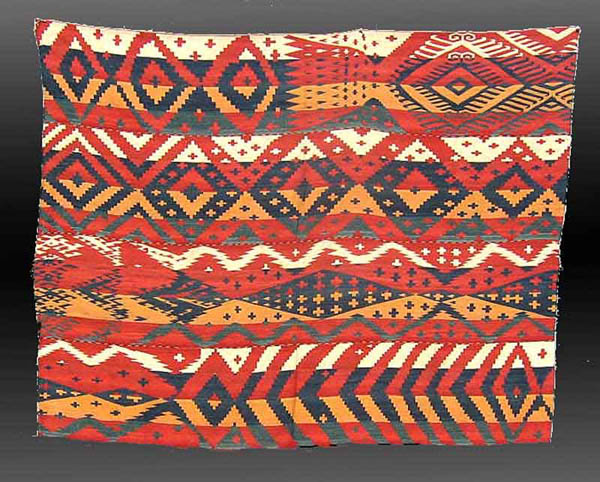
I found this interesting weaving, Uzbek production consisting of wide
bands sew together and seemingly of weft float and flatweave.
Granted
this is still not a perfect match. Maybe this says as much about the limitations
of warp and weft in relation to symmetry as as anything
else?
Dave











.jpg)



























